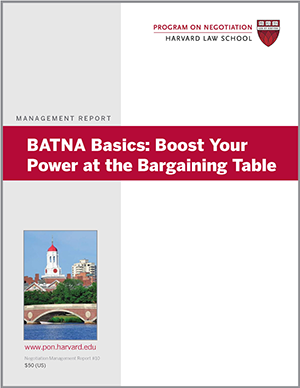
When it comes to great business negotiation strategies, there’s no better example than the cast of Friends in their heyday.
David Schwimmer, the actor who played Ross on the hit NBC sitcom Friends, famously convinced the show’s five other leads in the early years of its run to negotiate their contracts with NBC as a team. The “mini union” formed by the actors ultimately helped them negotiate an unprecedented $1 million each per episode during the show’s final season.
But if the TV network and the show’s producer, Warner Brothers, were willing to make steep concessions on salary to keep the cast, there was one issue that was not open to compromise. “The only time that I think we really put our foot down was when the cast wanted story approval,” show cocreator Marta Kauffman said on a panel at the National Association of Television Program Executives conference in January. Kauffman explained that she and cocreator David Crane worked collaboratively with the cast and were open to their story pitches, as reported in Broadcasting & Cable magazine. But the show runners resisted giving the cast veto power over scripts.
Kauffman’s anecdote reminds us of a fundamental fact of negotiation: Typically, multiple issues are at stake (here, salary and creative control, to name just two), and parties have different preferences across these issues. By making tradeoffs based on what each side values most, negotiators may be able to avoid impasse, at the very least—and, at the most, create a larger pie to carve up.
“Friends was a gorgeous, generous pie, and everyone had slices,” said Kauffman of the show, which ran from 1994 to 2004. But what happens when the pie is disappointingly small? Instead of Friends, imagine a network show that is experiencing a ratings free fall. When few resources are at stake and when conflict is brewing, negotiators have to work hard to both create new sources of value through collaborative moves and claim as much value as they can.
Business negotiation strategies: When to share, when to hold back
The tension between creating and claiming value is pivotal in business negotiation strategies, write Robert H. Mnookin, Scott R. Peppet, and Andrew S. Tulumello in their book Beyond Winning: Negotiating to Create Value in Deals and Disputes (Harvard University Press, 2000). Share too little information about your interests in a negotiation, and you will have difficulty identifying possible value-creating tradeoffs. Share too much, and the other side may take advantage of you.
Imagine, for example, that a woman named Jane is trying to sell her car because she is moving overseas soon. Her natural inclination might be to hide the fact that she is facing such a time deadline. After all, prospective buyers might wait out the clock in the hope of getting a steal from her at the last minute. On the other hand, explaining that she needs to sell the car quickly because she is moving overseas might reassure buyers concerned that she is in a rush to unload a lemon. Providing this information might allow Jane to sell for a higher price than if she did not disclose that she’s moving.
How can you create more value for all the parties involved while minimizing the risk of being exploited? The tension cannot be fully resolved, caution Mnookin and his coauthors. But as part of your negotiation preparation, they advise you to follow a number of steps that can improve your odds of reaching a better-than-satisfactory deal. Here are four of them.
1. Identify issues and interests.
One of the first steps in preparing for a negotiation is to think about the array of issues that could be discussed, as well as the interests of each party. But too often, we approach negotiation with a narrow mind-set. If the value swirling around a negotiation appears to be anything less than a “gorgeous, generous pie,” we tend to assume that we will be fighting with our counterpart to grab as much as we can.
This win-lose mind-set is what Harvard Business School professor Max H. Bazerman refers to as the “mythical fixed pie” of negotiation. Rather than looking for ways to expand the pie, we focus on carving it up. Rather than capitalizing on our different preferences, we accept impasse. By contrast, when parties can trade on their preferences across different issues, they reduce the need to haggle over price and percentages.
As part of your preparation for important negotiations, make a list of all the possible issues that may be at stake. Then consider your interests and your counterpart’s interests in each one. In addition to identifying tangible interests, such as price and deadlines, don’t forget intangible ones, such as building a long-term relationship or saving face in the aftermath of an error.
2. Contemplate value-creating opportunities.
Once you have identified your interests and the likely interests of the other party, it is time to begin thinking about the types of value-creating trades you might offer, write Mnookin, Peppet, and Tulumello in Beyond Winning.
In a New York Times post, Deb Weidenhamer, the founder and CEO of Auction Systems Auctioneers & Appraisers, describes what happened when an agreement she had reached in China went awry. Her team had negotiated a deal to auction products from a luxury watchmaker. Following her company’s standard business model, the retailer agreed to allow the bidding to start at a steep 80% off the retail price.
Later, when inventory was due to be delivered, however, the client rejected the agreed-upon starting price. By this point, Weidenhamer’s company had already advertised and marketed the client’s auction, so bowing out wasn’t an option. Moreover, Weidenhamer saw no point in arguing over the details of the signed contract.
Over the course of several long meetings, Weidenhamer and her team identified a key interest of her client’s and suggested an irresistible trade: In exchange for the Chinese company accepting the starting bid, the American company would hand over the contact information of auction participants, who would be informed.
“In the end,” writes Weidenhamer, “it was a win-win settlement.” The client expanded its database of luxury buyers, and Weidenhamer’s company gained credibility from its association with the respected brand—in addition to retaining its standard starting point for bids.
3. Assess and improve your BATNA when possible.
When managing the tension between creating and claiming value, you must determine the point at which you would walk away from the current negotiation and accept your best alternative to a negotiated agreement, or BATNA, write the authors of Beyond Winning. Because it allows you to reject a mediocre agreement, a strong BATNA is typically your best source of power in a negotiation.
After identifying your BATNA, you should take steps to improve it, when possible. To take a simple example, suppose you’re feeling uninspired in your current job and ready for a change. You have a string of interviews with a start-up and believe you are about to get an offer. How can you avoid accepting a package that would require you to compromise more than you’d like on issues such as salary? You might explore the possibility of taking on more interesting responsibilities with your current employer (perhaps for higher pay) or you might expand the scope of your job search.
Looking to make a trade? Consider these valuable resources in your business negotiation strategies.
Consider these potential sources of value, detailed in Beyond Winning:
Resources. Do you and the other party have different assets that you could trade (such as inventory, connections, or investments)?
Different valuations. Are there items that you value more than the other party does, and vice versa?
Forecasts. Do you have different predictions about the likelihood of a future event (such as the solvency of a business) that you could bet on in your contract?
Risk preferences. Do you have different preferences regarding risks and/or a different ability to absorb risk?
Time preferences. Do you have different short-term versus long-term interests?
You should also think about what your negotiating counterpart will do if she is unsatisfied with what you are offering, as this will affect how hard you can push when it comes time to claim value. As they approached their final year of shooting, the cast of Friends, for example, understood that NBC and Warner Brothers had no strong BATNA. The show was surging in the ratings, and fans were eagerly anticipating satisfying resolutions for their favorite characters. With the cast negotiating as a unit, NBC and Warner Brothers had to deal with them as such—and accept virtually any financially sustainable demand they made.
4. Set reservation values and aspirations.
Another important part of your business negotiation strategy preparation is to assess two values: your reservation value, or bottom line—the least you will accept in the current negotiation—and an ambitious yet realistic aspiration level, or goal.
Your reservation value typically will be closely tied to your BATNA. If you are choosing between two very similar used cars and know that one has a firm price of $10,000, then this will be the reservation value in your negotiation for the other car: There may be no reason for you to buy it for more than that amount.
Reservation values can be much harder to calculate in more complex negotiations, as when you are weighing two job offers that vary on dimensions such as salary, responsibility, and benefits. It would be a mistake, for example, to fixate on salary as your reservation value to the exclusion of other issues. In this case, you might want to set up a scoring system—a grid that allows you to assign point values to different options and make comparisons across your various alternatives.
It’s at least as important to set a clear aspiration level in your negotiations. Ideally, you should aspire to an outcome that is better than your BATNA, write Mnookin, Peppet, and Tulumello. That doesn’t mean making outrageous demands; rather, prepare arguments that will make your aspirations seem reasonable. Though you are unlikely to get everything you asked for, you should be able to anchor any haggling that follows around an ambitious yet realistic aspiration level.
What’s your experience sharing information and using techniques like these in business negotiation strategies?





